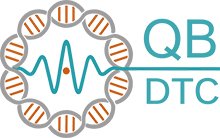

DNA repair
The cyclobutane dimer is formed between adjacent thymine nucleotides after ultraviolent damage, and due to the importance of their timely removal, there are several established repair mechanisms existing across species. It is unknown if nucleotide-based repair mechanisms can occur in nature, and not fully understood how the repair enzyme photolyase functions.
Overview
Electron movement involved in the repair of the cyclobutane dimer cannot be modelled without considering quantum mechanics. A nucleotide-based repair mechanism would require long-lasting excited states [1,2], whilst the transfer mechanism from the catalytic cofactor of photolyase could be explained as: quantum tunnelling, super-exchange, hopping, and proton-coupled electron transfer through water wire. The latter is known to depend on the wavelength of absorbed light, photolyase species and temperature of the enzyme [3-7].
Current projects

Computational investigations of quantum tunnelling in enzyme-catalyzed transfer reaction through quantum mechanics and molecular modelling
Max Winokan
Postgraduate researcher

Multiscale investigation on the quantum effects of photo-induced induced DNA repair
Roisin Guthrie
Postgraduate researcher
Project description
An excited electron introduced into a pyrimidine dimer, formed in DNA between two pyrimidine bases after UV damage, can induce repair. This electron can be donated by photoinduced processes involving the surrounding nucleotide sequence, deoxyribozymes or photolyase.
Our focus will be the repair of the Cyclobuthane thymine dimer and modelling applying multiscale quantum mechanics/molecular mechanics (QM/MM) methods. Roisin will start by attempting to find computational proof of the mechanism proposed by Bucher et al. [1], which shows how electron transfer across guanine and adenine to the dimer after UVC excitation can lead to dimer repair. In the long- term we will model other methods of photo-induced DNA repair after electron transfer, from a surrounding damaged nucleotide [2] or the FAD co-factor of photolyase.
Supervisors
Research team

Professor Jim Al-Khalili
Distinguished Professor Emeritus in Physics

Dr Marco Sacchi
Associate Professor of Physical and Computational Chemistry, Theme Leader in Sustainable Energy and Materials Research, Co-Director of the Quantum Biology Centre
References
[1] Bucher, D., Kufner, C., Schlueter, A., Carell, T., & Zinth, W. (2016, 1 13). UV-Induced Charge Transfer States in DNA Promote Sequence Selective Self-Repair. Journal of the American Chemical Society, 138(1), 186-190.
[2] Nguyen, K., & Burrows, C. (2011, 9 21). A prebiotic role for 8-oxoguanosine as a flavin mimic in pyrimidine dimer photorepair. Journal of the American Chemical Society, 133(37), 14586-14589.
[3] Liu, Z., Tan, C., Guo, X., Kao, Y., Li, J., Wang, L., Sancar, A., Zhong, D. (2011). Dynamics and mechanism of cyclobutane pyrimidine dimer repair by DNA photolyase. Biophysics and Computational Biology Chemistry, 108(36), 14831-14836.
[4] Rousseau, B., Shafei, S., Migliore, A., Stanley, R., & Beratan, D. (2018, 2 28). Determinants of Photolyase's DNA Repair Mechanism in Mesophiles and Extremophiles. Journal of the American Chemical Society, 140(8), 2853-2861.
[5] Lee, W., Kodali, G., Stanley, R., & Matsika, S. (2016). Coexistence of Different Electron-Transfer Mechanisms in the DNA Repair Process by Photolyase. Chemistry - A European Journal, 22(32), 11371-11381.
[6] Liu, Z., Tan, C., Guo, X., Li, J., Wang, L., Sancar, A., & Zhong, D. (2013, 8 6). Determining complete electron flow in the cofactor photoreduction of oxidized photolyase. Proceedings of the National Academy of Sciences of the United States of America, 110(32), 12966-12971.
[7] Wang, H., Chen, X., & Fang, W. (2014, 11 5). Excited-state proton coupled electron transfer between photolyase and the damaged DNA through water wire: A photo-repair mechanism. Physical Chemistry Chemical Physics, 16(46), 25432-25441